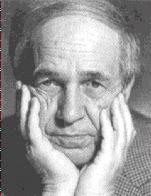

He studied with Messiaen at the Paris Conservatoire (1942-5) and privately with Andrée Vaurabourg and René Leibowitz, inheriting Messiaen's concern with rhythm, non-developing forms and extra-European music along with the Schönberg tradition of Leibowitz. The clash of the two influences lies behind such intense, disruptive works as his first two piano sonatas (1946, 1948) and Livre pour quatuor for string quartet (1949). The violence of his early music also suited that of René Char's poetry in the cantatas Le visage nuptial (1946) and Le soleil des eaux (1948), though through this highly charged style he was working towards an objective serial control of rhythm, loudness and tone colour that was achieved in the Structures for two pianos (1952). At this time he came to know Stockhausen, with whom he became a leader of the European avant garde, teaching at Darmstadt (1955-67) and elsewhere, and creating one of the key postwar works in his Le marteau sans maître (1954). Once more to poems by Char, the work is for contralto with alto flute, viola, guitar and percussion: a typical ensemble of middle-range instruments with an emphasis on struck and plucked sounds. The filtering of Boulez's earlier manner through his 'tonal serialism' produces a work of feverish speed, unrest and elegance.
In the mid-1950s Boulez extended his activities to conducting. He had been Barrault's musical director since 1946 and in 1954 under Barrault's aegis he set up a concert series, the Domaine Musical, to provide a platform for new music. By the mid-1960s he was appearing widely as a conductor, becoming chief conductor of the BBC Symphony Orchestra (1971-4) and the New York Philharmonic Orchestra (1971-8). Meanwhile his creative output declined. Under the influence of Mallarmé he had embarked on three big aleatory works after Le marteau, but of these the Third Piano Sonata (1957) remains a fragment and Pli selon pli for soprano and orchestra (1962) has been repeatedly revised; only a second book of Structures for two pianos (1961) has been definitively finished. Other works, notably Eclat/Multiples for tuned percussion ensemble and orchestra, also remain in progress, as if the openendedness of Boulez's proliferating musical world had committed him to incompleteness. Only the severe memorial Rituel for orchestra (1975) has escaped that fate.
Since the mid-1970s Boulez has concentrated on his work as director of the Institut de Recherche et Coordination Acoustique/Musique, a computer studio in Paris where his main work has been Répons for orchestra and digital equipment.